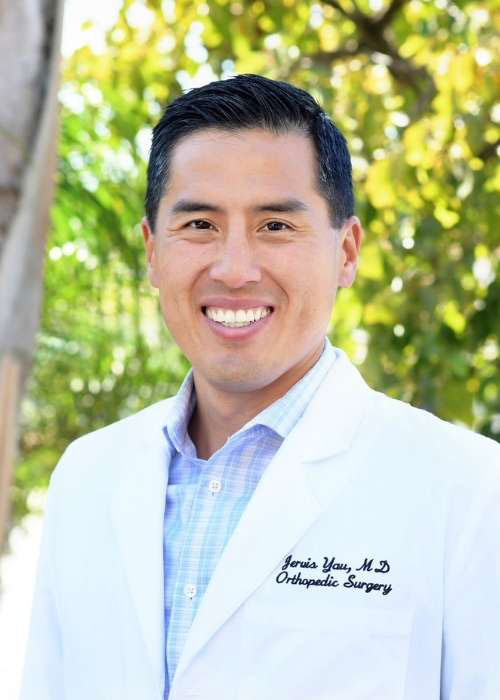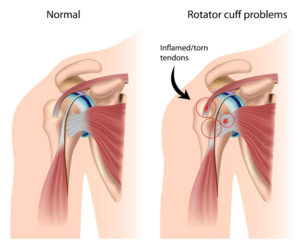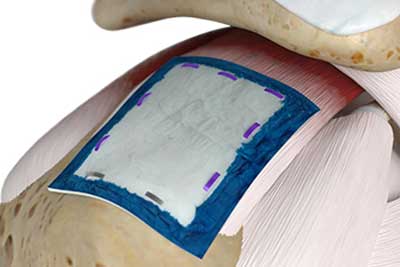Rotator Cuff Injury Specialist

Are you an athlete who participates in sports that involve throwing overhead? If so, you may be at risk of sustaining a rotator cuff tear. A rotator cuff tear is typically caused by a fall, sports injury or degeneration. Rotator cuff injury specialist, Dr. Jervis Yau provides diagnosis and both surgical and nonsurgical treatment options for patients in Santa Barbara who have sustained a rotator cuff injury. Contact Dr. Yau’s team today!
Rotator Cuff Injury Overview
The rotator cuff is an extremely important structure located within the shoulder joint responsible for stabilizing the shoulder and allowing overhead motion of the arm. Composed of four muscle-tendon units, the rotator cuff muscles include the supraspinatus, infraspinatus, subscapularis and teres minor. If any of the muscle-tendon units sustain injury, patients may experience shoulder pain and loss of motion. A rotator cuff tear is commonly seen as the tendon degenerates with aging and overuse. It is unusual to see rotator cuff tears in patients under the age of 50 unless there has been significant trauma to the shoulder. Santa Barbara, Goleta, Santa Maria and Ventura, California orthopedic shoulder specialist, Dr. Jervis Yau focuses on rotator cuff treatment, both surgical and non-surgical, to return patients to the athletic activities following a rotator cuff tear.
What Causes a Rotator Cuff Tear?
A rotator cuff injury is commonly marked by “tearing” of the tendon attachment from the humerus (upper arm bone). A rotator cuff tear typically occurs from:
- Acute trauma- A hard hit or fall from a height
- Overuse- Repetitive, continuous overhead motions associated with athletic activities, such as pitching, swimming and tennis
- Degeneration- Normal wear and tear from the natural aging process causes a collagen breakdown, making the tendons and muscles more prone to injury
A rotator cuff tear may also be associated with tendonitis or shoulder impingement in certain patients. Injuries to the rotator cuff can range from mild strain to complete tear.
What are the Symptoms of a Rotator Cuff Tear?
Rotator cuff tears are characterized by pain over the top and side of the shoulder. Pain may also be referred down towards the elbow joint and often interferes with sleep. Another common symptom many patients experience is joint weakness. The combination of pain and weakness can make activities of daily living difficult.
How is a Rotator Cuff Tear Diagnosed?
Diagnosis is obtained thorough a thorough history and physical examination looking for weakness, loss of motion, muscle and pain. Dr. Yau commonly performs X-rays and MRI scan to assess the severity of injury.
What is the Treatment for a Rotator Cuff Tear?
Treatment of rotator cuff injuries largely depends on the type, partial versus full-thickness tears, chronicity, age and activity level.
Non-Surgical
The overall goal of non-surgical treatment is to reduce pain and inflammation while strengthening the uninjured muscles around the shoulder joint to offset the torn tendon or muscle. Dr. Yau achieves this with a combination of rest, ice/heat, activity modification, anti-inflammatory medications (NSAIDs) and physical therapy.
Surgical
An arthroscopic rotator cuff repair is performed by Dr. Yau if conservative measures fail or if the rotator cuff tear is too severe. During the arthroscopic treatment, Dr. Yau will use an arthroscope (tiny camera) and special minimally invasive instruments to examine and repair the damaged tissue. Arthroscopic surgery is typically utilized to achieve maximum recovery with less pain and quicker return to activities.
How can a Rotator Cuff Tear be treated with REGENETEN?
REGENETEN is a Bioinductive Implant that is the size of a postage stamp. Regeneten offers an advanced healing solution for biological enhancement and tendon regeneration across all rotator cuff tear types. Dr. Yau uses this small collagen implant as a solution and healing option for a rotator cuff tear. Regeneten offers a faster recovery and a higher repair strength of the rotator cuff. You can learn more about the REGENETIEN Bioinductive Implant HERE.
For additional resources on a rotator cuff injury, such as a rotator cuff tear, or on the excellent treatment options available, especially REGENETEN Bioinductive Implant, please contact Dr. Jervis Yau, orthopedic shoulder specialist in the Santa Barbara, Goleta, Santa Maria and Ventura, California communities.
Rotator Cuff Injury FAQ
1. What does it feel like to have a torn rotator cuff?
A rotator cuff tear will cause pain in the front of the shoulder that radiates down the side of the arm. The pain may be present with overhead activities such as reaching or lifting. Patients with a rotator cuff tear may also experience pain when sleeping on the affected shoulder. Weakness and difficulty performing routine activities such as brushing hair or reaching behind the back may be present.
2. How do you sleep with a torn rotator cuff?
It is common for patients with a rotator cuff tear to have problems sleeping. Before going to bed, icing the injured shoulder for 15 to 20 minutes can help reduce inflammation and pain. When prescribed by a doctor, taking an anti-inflammatory such as ibuprofen can help reduce inflammation. Adjusting position while sleeping can help ease pain. Sleeping in the reclined position may be more comfortable than lying flat. There are a few ways to sleep in a reclined position:
- Using several pillows behind your back, while lying in the bed or couch
- Sitting in a recliner with an armrest
Patients can also try lying flat on their back with the injured arm propped up with a pillow. Using a pillow may reduce stress and pressure on the injured side. Patients can also try to lie on the opposite, uninjured side.
3. How do rotator cuff tears occur?
Due to the mobility of the shoulder joint, the shoulder is susceptible to a rotator cuff tear. Rotator cuff tears can occur due to a traumatic injury, degeneration of tissue and impingement in the shoulder.
- A traumatic injury is typically caused by a fall on an outstretched arm, lifting heavy weight overhead, or activities that place tremendous stress on the shoulder like holding a waterskiing tether.
- As people age, the rotator cuff can degenerate. Those who are in an occupation or an athlete that commonly raises and lowers the arm can also suffer from degeneration in the shoulder.
- Rotator cuff degeneration can be associated with impingement. Shoulder impingement is a painful pinching of muscles, tendons and other soft tissue structures that sandwich in the subacromial space. Structural and functional issues can lead to impingement in the shoulder and ultimately a rotator cuff tear.
4. What are the symptoms of a torn rotator cuff?
Rotator cuff symptoms can include:
- Limited range of motion in the shoulder
- Pain when reaching overhead
- Dull ache deep in the shoulder
- Weakness in the arm
- Disrupted sleep, particular on the injured side
5. How do you know if you tore your rotator cuff?
Only a physician can definitively diagnose a rotator cuff tear, but there are a number of symptoms that are associated with a rotator cuff injury. Rotator cuff tears can happen immediately in a traumatic event such as a fall on an outstretched arm. During a traumatic injury, symptoms can occur almost immediately. In an overuse situation, symptoms occur gradually. Pain can be dull and achy, especially when reaching over head or during sleep. Weakness can be felt with daily activities such as throwing a baseball or even with simple tasks such as brushing teeth. In some cases, symptoms can cause a feeling of catching and locking in the shoulder.
6. What happens if you don’t fix a torn rotator cuff?
The severity of the rotator cuff tear and the patient’s activity level will help determine the correct treatment plan. If a rotator cuff tear is left untreated, the injury can become more severe or get larger overtime. An increase in pain can occur with repetitive use or re-injury of the rotator cuff. If a patient knows there is a rotator cuff tear present, an increase in pain and decrease in strength may mean that the tear is getting larger.
7. Can a rotator cuff heal on its own?
Even though most rotator cuff tears cannot heal on their own, return of function can be achieved without surgery. The goal of non-operative treatment is to relieve pain and restore strength. In cases of a low-grade partial rotator cuff tear, patients can use non-operative measures such as rest, ice, anti-inflammatory medication and physical therapy. If patients are active and use the arm for overhead work or sports, then surgery is typically recommended to repair the rotator cuff tear back to full function.
8. How is rotator cuff surgery performed?
During arthroscopic rotator cuff surgery, Dr. Yau will identify the rotator cuff tear and reattach it to its attachment site on the humerus. The repair is done through use of special suture anchors that are placed within the bone. These anchors are attached to sutures that are used to sew the torn tendons back down to its attachment site on the bone.
If necessary, Dr. Yau will perform a double row repair to add stability to the injury. This technique consists of two rows of anchors in the bone with sutures in between to secure the torn tendon back to its original attachment site.

